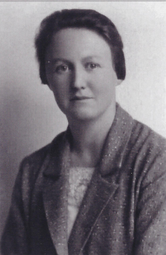 Engineer of the Week No.46: Hilda Margaret Lyon MA., MSc., AFRAeS. (31st May 1896- 2nd December 1946) Hilda Margaret Lyon was born in Market Weighton in 1896, into a family of farmers and grocers. She had 4 older siblings but, out of the whole family, she seems to have been the only one to have travelled and lived out of the area. Educated at Beverley High School, Hilda went on to graduate with a mathematics degree from Newnham College, Cambridge in 1918. Her first job was as a technical assistant at Siddeley Deasy Motor company in Coventry, but in 1920 she moved into her first aeronautical post, At George Parnall & Co, an aircraft manufacturer. In 1922 she became an associate fellow of the Royal Aeronautical Society and in 1925 joined the Royal Airship Works in Cardington. This started a fruitful period of research for Hilda and the Aeronautical Journal published her very important paper on the strength of transverse frames of rigid airships in 1930, for which she was the first woman to be awarded the R38 Memorial Prize by the Royal Aeronautical Society. The same year she went to do 2 years of postgraduate study at the Massachusetts Institute of Technology on a Mary Ewart Travelling Scholarship. This gave her her first access to wind tunnels and she submitted her thesis on "The Effect of Turbulence on the Drag of Airship Models" to obtain her MA from MIT in 1932. That work took her next to Göttingen in Germany, where she conducted aerodynamics research at the Kaiser Wilhelm Gesellschaft für Strömungsforschung with Ludwig Prandtl. However, this was cut short when her mother was taken ill and Hilda was forced to return home to care for her in Yorkshire. Fortunately, this potentially career-killing domestic obligation was overcome by her former supervisors a the Royal Aircraft Establishment who, understanding her talents, encouraged her to continue her work from home. In the 2 years before her mother's death in 1934, Hilda published 2 papers on streamlining and boundary layer effects and two more in 1935 before the RAE was able to create a post for her to return as a full time Principal Scientific Officer in the aerodynamics department in 1937. Despite not being employed in the field from 1932-37, she was recognised in a 1934 issue of Flying Magazine as being "...the classic authority on the subject of stresses in transverse frames". From 1937 onwards she was publishing frequently, up to and even after her death. Her war work included work on stability analysis of the Hurricane's rudder. In 1946 she died following an operation and her death was keenly-felt in the aeronautical world as a great loss to the field.She is buried in her home town, in Market Weighton Cemetery.
After her death, her research and the "Lyon Shape" which she devised were incorporated into the American submarine USS Albacore, which had the prototype streamlined hull form for almost all subsequent US submarines, and those of many other nations. The Lyon Shape may even have been in use in the 1944 German midget submarines (Delfins), which suggests that her brief work at Gottingen may have influenced scientists there. The "Lyon shape" term is widely used in the USA but less known elsewhere. Her 1942 paper, "A theoretical analysis of longitudinal dynamic stability in gliding flight" is considered seminal and continues to be cited in the science of streamlining and boundary layers.A further legacy was a Hilda Lyon Prize for RAE apprentices which was awarded for some years after her death. The girl from Market Weighton travelled far but her professional legacy travelled much further and she is now becoming better recognised and becoming a great historical role model for potential young engineers today. A commemorative plaque is to be installed on her father's old shop premises in Marke Weighton high street.
0 Comments
Leave a Reply. |
- Home
- Electric Dreams
- All Electric House, Bristol
- Top 100 Women
- Engineer of the Week
- The Women
- Timeline
- WES History
- EAW
- Teatowels For Sale
- 50 Women in Engineering
- Museum Trails
- Waterloo Bridge
- History Links
- Blue Plaques
- Virtual Blue Plaques
- Career and Inspiration Links
- Contact
- Outreach
- Photo Gallery
- Bluestockings and Ladders
